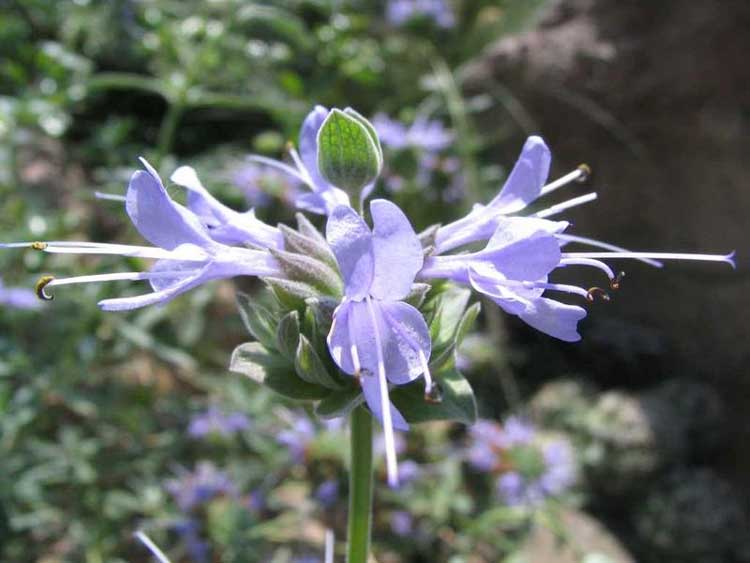
Salvia clevelandii (Photo: *)
Classification System: APG IV
Superregnum: Eukaryota
Regnum: Plantae
Cladus: Angiosperms
Cladus: Eudicots
Cladus: Core eudicots
Cladus: Asterids
Cladus: Lamiids
Ordo: Lamiales
Familia: Lamiaceae
Subfamilia: Nepetoideae
Tribus: Mentheae
Subtribus: Salviinae
Genus: Salvia
Subgenus: S. subg. Sclarea
Sectio: S. sect. Echinosphace
Species: Salvia clevelandii
Name
Salvia clevelandii (A.Gray) Greene, 1892
Synonyms
Basionym
Audibertia clevelandii A.Gray, Proc. Amer. Acad. Arts 10: 76 (1874).
Homotypic
Audibertiella clevelandii (A.Gray) Briq., Bull. Herb. Boissier 2: 73 (1894).
Ramona clevelandii (A.Gray) Briq. in H.G.A.Engler & K.A.E.Prantl, Nat. Pflanzenfam. 4(3a): 287 (1896).
Distribution
Native distribution areas:
References
Primary references
Greene, E.L., 1892. Pittonia; a Series of Papers Relating to Botany and Botanists. Berkeley, CA 2:236.
Additional references
Govaerts, R.H.A. 2003. World Checklist of Selected Plant Families Database in ACCESS: 1-216203. The Board of Trustees of the Royal Botanic Gardens, Kew. [unavailable for the public] Reference page.
Links
Govaerts, R. et al. 2022. Salvia clevelandii in World Checklist of Selected Plant Families. The Board of Trustees of the Royal Botanic Gardens, Kew. Published online. Accessed: 2022 May 09. Reference page.
Hassler, M. 2022. Salvia clevelandii. World Plants: Synonymic Checklists of the Vascular Plants of the World In: Roskovh, Y., Abucay, L., Orrell, T., Nicolson, D., Bailly, N., Kirk, P., Bourgoin, T., DeWalt, R.E., Decock, W., De Wever, A., Nieukerken, E. van, Zarucchi, J. & Penev, L., eds. 2022. Species 2000 & ITIS Catalogue of Life. Published online. Accessed: 2022 May 09. Reference page.
Tropicos.org 2022. Salvia clevelandii. Missouri Botanical Garden. Published online. Accessed: 09 May 2022.
International Plant Names Index. 2022. Salvia clevelandii. Published online. Accessed: May 09 2022.
Vernacular names
English: Cleveland sage, Blue sage, Fragrant sage
Salvia clevelandii, the fragrant sage,[1] blue sage, Jim sage and Cleveland sage, is a perennial plant that is native to Southern California and northern Baja California, growing below 900 m (3,000 ft) elevation in California coastal sage and chaparral habitat. The plant was named in 1874 by Asa Gray, honoring plant collector Daniel Cleveland.[2][3]
Description
Salvia clevelandii leaves
Salvia clevelandii is an evergreen shrub that reaches 1 to 1.5 m (3.3 to 4.9 ft) in height and width. The fragrant, ashy green leaves are obovate and rugose, growing less than 2.5 cm (0.98 in) long. Flowers are on 30 cm (12 in) spikes, with numerous whorls of upright amethyst blooms opening in June–July.[2]
Phytochemistry
The rose potpourri scented foliage of hybrids is composed of camphor and 1,8-cineole. Named cultivars with a eucalyptus scent also contain around 20% 1,8-cineole.[4]
Taxonomy
This species was described in 1874 as Audibertia clevelandii (the basionym) by Asa Gray, named in honor of Daniel Cleveland. Cleveland was an amateur botanist and civic leader from San Diego, who had taken an interest in the local flora and fauna, sending his collections to Gray over a 20-year correspondence.[3][5]
In the wild, this species may hybridize with Salvia apiana and Salvia mellifera.[6][7]
Distribution and habitat
This species is found throughout portions of Southern California and northwestern Baja California, in chaparral and coastal sage scrub. It is distributed along the coast of San Diego County, the Peninsular Ranges of San Diego and Orange counties, and in northwestern Baja California, from the border to the northern portion of the Central Desert in the southern Sierra de San Pedro Martir.[8]
Cultivation
Salvia clevelandii is a popular Southwest USA landscape plant, cultivated since the 1940s. Plants prefer dry summers, good drainage, and tolerate full sun in cooler areas. As a landscape plant they have a relatively short life span of five to ten years. They are hardy to −7 °C (19 °F).
Cultivars and hybrids include:
'Winnifred Gilman', a popular cultivar with intense violet-blue flowers.
'Betsy Clebsch', a shorter cultivar with wide variation in flower color.
'Allen Chickering', 'Aromas', 'Pozo Blue', 'Santa Cruz Dark', and 'Whirly Blue' are hybrids with similar appearance.[2]
Salvia clevelandii is one of the parents of the hybrid Salvia 'Celestial Blue'.
Notes
USDA, NRCS (n.d.). "Salvia clevelandii". The PLANTS Database (plants.usda.gov). Greensboro, North Carolina: National Plant Data Team. Retrieved 28 October 2015.
Clebsch, Betsy; Barner, Carol D. (2003). The New Book of Salvias. Timber Press. pp. 78–81. ISBN 978-0-88192-560-9.
"Who was Salvia clevelandii named for?". Smarty Plant. Lady Bird Johnson Wildflower Center, the University of Texas at Austin. "[T]he author of the species chose to honor Daniel Cleveland, a nineteenth century lawyer, amateur botanist, plant collector and co-founder of the San Diego Society of Natural History. [...] there are a number of other species named in his honor, including: Cheilanthes clevelandii, Chorizanthe clevelandii, Cryptantha clevelandii, Dodecatheon clevelandii, Horkelia clevelandii, Malacothrix clevelandii, Mimulus clevelandii, Muilla clevelandii, Nicotiana clevelandii and Penstemon clevelandii. Moreover, the monotypic Mexican genus, Clevelandia (now included in Castilleja) was also named in Mr. Cleveland's honor. [The fish genus Clevelandia was as well.]"
Debaggio, Thomas; Tucker, Arthur O. (2009). The Encyclopedia of Herbs. ISBN 9781604691344. Retrieved 10 May 2021.
"Daniel Cleveland (1838–1929)". San Diego Natural History Museum. San Diego Society of Natural History. Retrieved January 5, 2022.
Montalvo, A. M. and J. L. Beyers. 2010. Plant Profile for Salvia apiana. Native Plant Recommendations for Southern California Ecoregions. Riverside-Corona Resource Conservation District and U.S. Department of Agriculture, Forest Service, Pacific Southwest Research Station, Riverside, CA. Online: http://www.rcrcd.com/index.php?option=com_content&view=article&id=88&Itemid=190
Montalvo, A. M., E. C. Riordan, and J. L. Beyers. 2017. Plant Profile for Salvia mellifera, Updated 2017. Native Plant Recommendations for Southern California Ecoregions. Riverside-Corona Resource Conservation District and U.S. Department of Agriculture, Forest Service, Pacific Southwest Research Station, Riverside, CA. Online: https://www.rcrcd.org/plant-profiles
Rebman, J. P.; Gibson, J.; Rich, K. (2016). "Annotated checklist of the vascular plants of Baja California, Mexico" (PDF). San Diego Society of Natural History. 45: 183.
Retrieved from "http://en.wikipedia.org/"
All text is available under the terms of the GNU Free Documentation License

